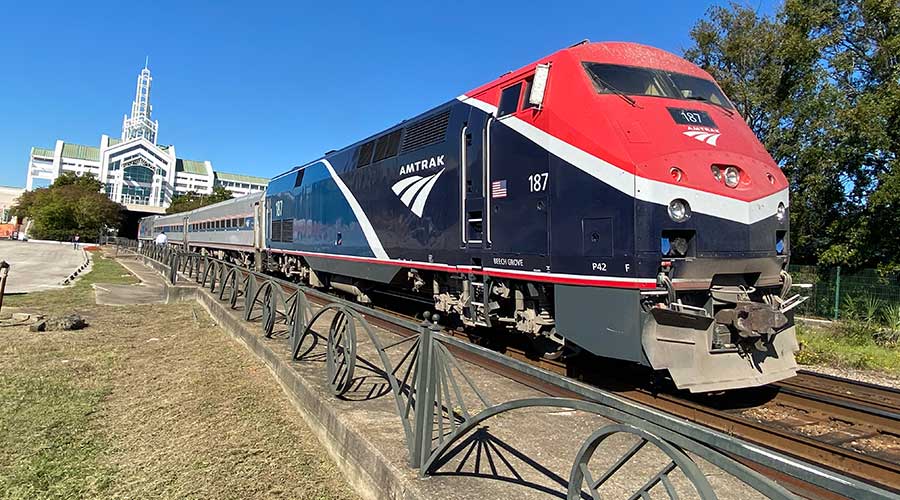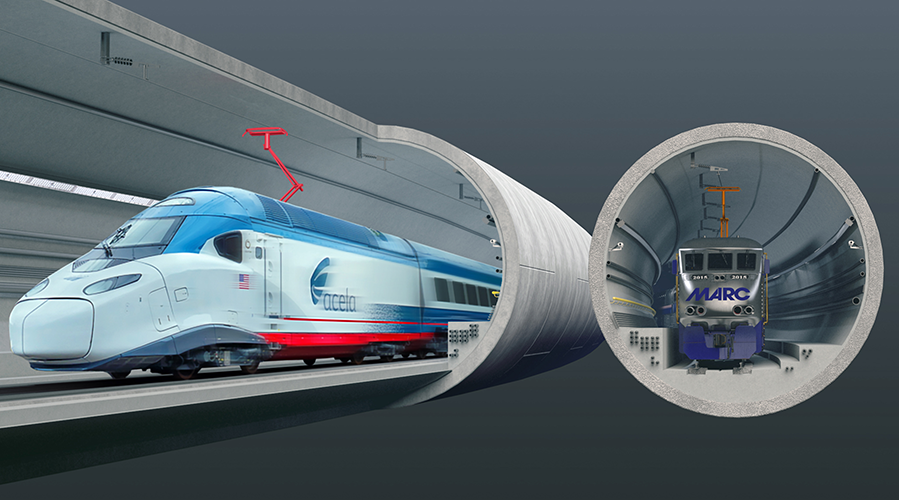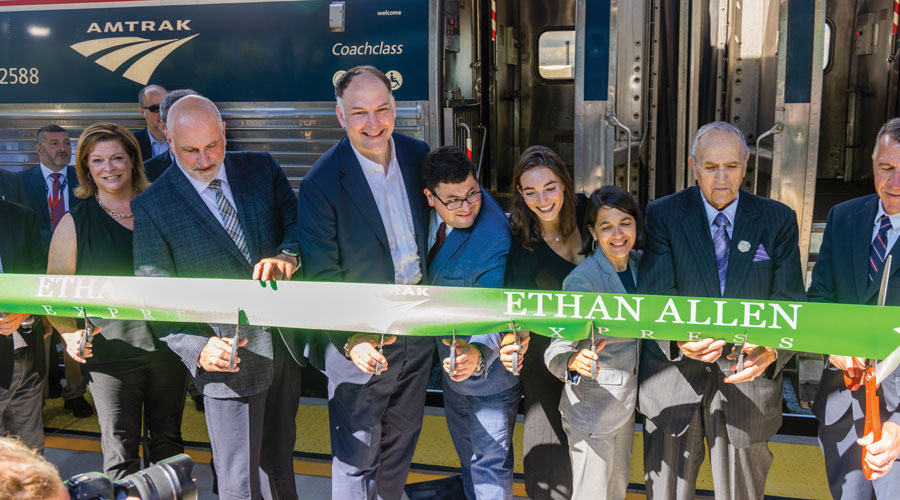Newsletter Sign Up
Stay updated on news, articles and information for the rail industry
Stay updated on news, articles and information for the rail industry
RAIL EMPLOYMENT & NOTICES
Rail News Home Amtrak
Rail News: Amtrak
September 2012
Rail News: Amtrak
Amtrak aims to bolster its aging infrastructure to accommodate mounting ridership despite funding limitations, says Boardman
advertisement
By Jeff Stagl, Managing Editor
The nation needs a balanced transportation system, one that places infrastructure investments for rail and bus systems on equal footing with dollars spent on highways and airports. If such a balance was achieved, Amtrak could realize its opportunities to expand capacity and bolster operations to better accommodate growing ridership, which has reached record levels the past 11 months.
That was the crux of Amtrak President and Chief Executive Officer Joseph Boardman's keynote address on Sept. 18 in Chicago during the chairman's luncheon at the American Railway Engineering and Maintenance-of-Way Association's annual conference and exposition. Amtrak has major plans in the works to expand capacity, improve infrastructure and realign routes — such as a Northeast Corridor (NEC) master plan and a "NextGen" high-speed rail initiative — but there are limits on what the national intercity passenger railroad can do with its old infrastructure and constrained budget, said Boardman.
"Amtrak has nearly every obstacle to growth: aging rolling stock, reliability challenges and run-down stations that are at or past capacity," he said.
Boardman also identified funding, environmental clearance and "coalition building" as major challenges that would need to be overcome in order for the railroad to fulfill its growth plans.
"Lack of investment really is the culprit," he said.
Despite the roadblocks, Amtrak is doing what it can to bolster infrastructure, especially along the NEC, which has "alignment and age issues," said Boardman. For example the railroad continues to replace the 105-year-old Niantic River Bridge in East Lyme, Conn., a $140 million project that's slated for completion in mid-2013, as part of an NEC upgrade program.
A tight squeeze
Studies suggest capacity on the NEC will become more constrained over time — the primary reason Amtrak drafted a $52 billion NEC master plan in 2010 that's designed to help the railroad "squeeze out capacity" along the route to 2030, said Boardman. The railroad will carry out long-range projects as funding becomes available, but for now, there is no money dedicated for the corridor, he added.
In July, Amtrak issued a report that integrates and updates the railroad's NEC and high-speed rail "vision plans." Essentially, Amtrak plans to accommodate more trains operating at faster speeds with significantly reduced trip times and improved service reliability, while at the same time develop 220-mph, next-generation high-speed rail, or NextGen HSR, along the NEC.
Building a dedicated two-track alignment along the NEC will allow a maximum speed of 220 mph, said Boardman.
"But we need government action first, not government inaction," he said. "If [NextGen and other plans] are implemented, it will dramatically improve trip times."
Whether the federal government takes any action of the funding kind for Amtrak remains to be seen. Rather than discuss ways to help the railroad carry out its growth plans, Congress is spending more time reviewing Amtrak's finances and spending, said Boardman. He expected to testify at a House Transportation and Infrastructure Committee hearing Sept. 20 in Washington, D.C., that seeks to explore monetary losses associated with Amtrak's operations, compare the railroad's federal subsidy with other passenger transportation modes and examine "management deficiencies" identified by the Amtrak Office of Inspector General, as characterized by a media advisory distributed by Rep. John Mica's (R-Fla.) office.
Regardless if all the growth-accommodating plans are completed now or in the future, the bottom line is that the work needs to be done, said Boardman.
"All of this will be done at some point in our history," he said.
The nation needs a balanced transportation system, one that places infrastructure investments for rail and bus systems on equal footing with dollars spent on highways and airports. If such a balance was achieved, Amtrak could realize its opportunities to expand capacity and bolster operations to better accommodate growing ridership, which has reached record levels the past 11 months.
That was the crux of Amtrak President and Chief Executive Officer Joseph Boardman's keynote address on Sept. 18 in Chicago during the chairman's luncheon at the American Railway Engineering and Maintenance-of-Way Association's annual conference and exposition. Amtrak has major plans in the works to expand capacity, improve infrastructure and realign routes — such as a Northeast Corridor (NEC) master plan and a "NextGen" high-speed rail initiative — but there are limits on what the national intercity passenger railroad can do with its old infrastructure and constrained budget, said Boardman.
"Amtrak has nearly every obstacle to growth: aging rolling stock, reliability challenges and run-down stations that are at or past capacity," he said.
Boardman also identified funding, environmental clearance and "coalition building" as major challenges that would need to be overcome in order for the railroad to fulfill its growth plans.
"Lack of investment really is the culprit," he said.
Despite the roadblocks, Amtrak is doing what it can to bolster infrastructure, especially along the NEC, which has "alignment and age issues," said Boardman. For example the railroad continues to replace the 105-year-old Niantic River Bridge in East Lyme, Conn., a $140 million project that's slated for completion in mid-2013, as part of an NEC upgrade program.
A tight squeeze
Studies suggest capacity on the NEC will become more constrained over time — the primary reason Amtrak drafted a $52 billion NEC master plan in 2010 that's designed to help the railroad "squeeze out capacity" along the route to 2030, said Boardman. The railroad will carry out long-range projects as funding becomes available, but for now, there is no money dedicated for the corridor, he added.
In July, Amtrak issued a report that integrates and updates the railroad's NEC and high-speed rail "vision plans." Essentially, Amtrak plans to accommodate more trains operating at faster speeds with significantly reduced trip times and improved service reliability, while at the same time develop 220-mph, next-generation high-speed rail, or NextGen HSR, along the NEC.
Building a dedicated two-track alignment along the NEC will allow a maximum speed of 220 mph, said Boardman.
"But we need government action first, not government inaction," he said. "If [NextGen and other plans] are implemented, it will dramatically improve trip times."
Whether the federal government takes any action of the funding kind for Amtrak remains to be seen. Rather than discuss ways to help the railroad carry out its growth plans, Congress is spending more time reviewing Amtrak's finances and spending, said Boardman. He expected to testify at a House Transportation and Infrastructure Committee hearing Sept. 20 in Washington, D.C., that seeks to explore monetary losses associated with Amtrak's operations, compare the railroad's federal subsidy with other passenger transportation modes and examine "management deficiencies" identified by the Amtrak Office of Inspector General, as characterized by a media advisory distributed by Rep. John Mica's (R-Fla.) office.
Regardless if all the growth-accommodating plans are completed now or in the future, the bottom line is that the work needs to be done, said Boardman.
"All of this will be done at some point in our history," he said.


 2025 MOW Spending Report: Passenger-rail programs
2025 MOW Spending Report: Passenger-rail programs
 Gardner steps down as Amtrak CEO
Gardner steps down as Amtrak CEO
 Guest comment: Oliver Wyman’s David Hunt
Guest comment: Oliver Wyman’s David Hunt
 Women of Influence in Rail eBook
Women of Influence in Rail eBook
 railPrime
railPrime







